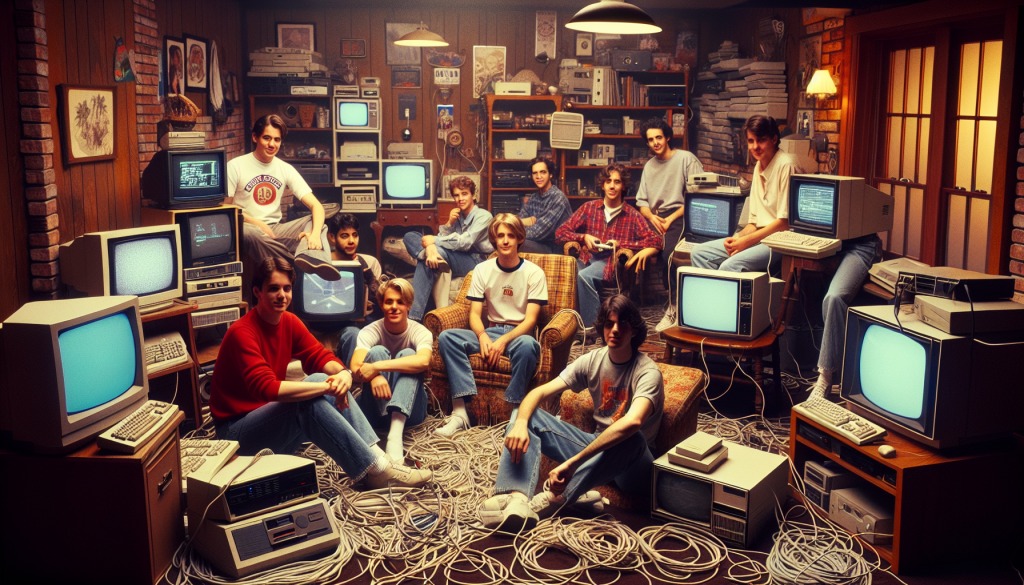Gaming has come a long way since its humble beginnings. It’s hard to believe that just a few decades ago, games were made up of simple pixels and basic shapes. But as technology advanced, so did the world of gaming. The introduction of 3D graphics revolutionized the industry, pushing the boundaries of what was possible and paving the way for the immersive gaming experiences we enjoy today.
The Early Days: From Pixels to Polygons
In the early days of gaming, graphics were limited by the capabilities of the hardware. Games were primarily 2D, consisting of blocky pixels and simple sprites. However, even with these limitations, game developers were able to create memorable experiences that captured the imaginations of millions of players.
As technology evolved, so did the graphics in games. The introduction of 3D graphics marked a significant milestone in the gaming industry. Suddenly, games were no longer confined to the flat world of pixels; they could now be brought to life in three dimensions.
With the advent of 3D graphics, game developers gained the ability to create more immersive and realistic worlds. Instead of using pixels, they could now use polygons to construct objects, characters, and environments. This opened up a whole new realm of possibilities in game design and storytelling.
One of the early pioneers of 3D graphics was the iconic game “Super Mario 64,” released for the Nintendo 64 console in 1996. This game marked a shift from the traditional 2D side-scrolling Mario games to a fully 3D platforming adventure. Players were introduced to a vibrant and interactive world, filled with colorful characters and dynamic environments.
Another breakthrough moment came with the release of the PlayStation 2 console in 2000. This console featured advanced graphics capabilities that allowed for even more realistic and detailed visuals. Games like “Gran Turismo 3” and “Final Fantasy X” showcased the power of the PlayStation 2, immersing players in breathtakingly lifelike worlds.
As the years went on, 3D graphics continued to evolve and improve. Game developers embraced new technologies and techniques to create increasingly detailed and realistic visuals. From the sprawling open worlds of games like “The Elder Scrolls V: Skyrim” to the stunningly lifelike character models of “Uncharted 4: A Thief’s End,” advancements in 3D graphics have played a significant role in shaping the gaming industry.
Today, we take advanced graphics for granted. It’s become the norm for games to feature stunning visuals that rival those of blockbuster movies. However, it’s important to remember the journey that brought us here. The early days of gaming may have been simple, but they laid the foundation for the incredible experiences we enjoy today.
So the next time you fire up your favorite game and marvel at the realistic landscapes and intricately designed characters, take a moment to appreciate the advancements in 3D graphics that made it all possible. And who knows what the future holds? With each passing year, technology continues to evolve, and the possibilities for gaming are limitless.
The Rise of 3D Graphics: A Game-Changer in the Gaming Industry
Remember the days when video games were nothing more than a collection of pixels on a screen? Those humble beginnings have now given way to a whole new era of gaming, thanks to the rise of 3D graphics. This technological advancement has completely revolutionized the gaming industry, offering players a level of immersion and realism that was once unimaginable.
Back in the early days of gaming, most games were played on 2D screens with simple graphics and limited depth. However, with the introduction of 3D graphics, everything changed. Suddenly, game worlds became more immersive and visually stunning. Characters and objects were no longer flat and lifeless, but instead had depth and realistic movements.
One of the biggest game-changers in this regard was the release of popular titles like Super Mario 64 and The Legend of Zelda: Ocarina of Time. These games introduced players to fully realized 3D environments, where they could freely explore vast landscapes and interact with a variety of objects. This new level of immersion created a sense of wonder and excitement that drew players in like never before.
As technology advanced, so did the capabilities of 3D graphics. Game developers began to push the boundaries even further, striving for ever greater realism. This led to the creation of games that were not just visually stunning, but also emotionally engaging.
Take for example, the critically acclaimed game, The Last of Us. Its detailed graphics and lifelike character animations allowed players to connect with the story on a deeper level. The game’s realistic visuals and emotional storytelling created an experience that was truly unforgettable.
But it’s not just the visual aspect that has been impacted by 3D graphics. The rise of this technology has also revolutionized gameplay mechanics. The introduction of 3D environments opened up new possibilities for exploration and interaction. Players could now navigate through complex levels, solve intricate puzzles, and engage in thrilling combat sequences, all thanks to the advancements in 3D graphics.
As a result, 3D graphics have significantly shaped gamer expectations and industry standards. Players now expect games to be visually stunning, with lifelike characters, detailed environments, and seamless animations. Developers, in turn, strive to meet these expectations by constantly pushing the boundaries of what is possible with 3D graphics.
So, what does this mean for the future of gaming? Well, the possibilities are truly endless. With the continuous advancements in technology, we can expect even more realistic and immersive experiences in the years to come. From virtual reality gaming to ray tracing, the future of 3D graphics holds immense potential.
As a gamer, it’s important to stay on top of these developments and embrace the ever-evolving world of 3D graphics. By doing so, you can fully immerse yourself in the incredible worlds that game developers create and appreciate the hard work and dedication that goes into bringing these experiences to life.
So, the next time you fire up your favorite game, take a moment to appreciate the amazing journey that has brought us from pixels to polygons and beyond. The rise of 3D graphics has truly been a game-changer in the gaming industry, and it’s only going to get better from here.
Pushing the Boundaries: Realism and Immersion in Modern Games
Ah, the world of modern gaming. It’s a place where you can leave reality behind and immerse yourself in breathtaking virtual worlds. One of the key factors that have made this possible is the constant push for realism in graphics. Gone are the days when game characters were just pixelated blobs on the screen. With the advancement of technology, developers have been able to create stunningly realistic visuals that transport players into a whole new dimension. The demand for realism in gaming graphics has been driven by the desire to create more immersive experiences. When you play a game, you want to feel like you’re actually part of that world, and realistic graphics play a crucial role in achieving that. Thanks to advancements in hardware and software, modern games can showcase stunning details and lifelike textures. From the intricate facial expressions of characters to the realistic physics of objects, every aspect of the gaming environment is meticulously designed to create a sense of authenticity. But it’s not just about making the games look pretty. Realistic graphics also serve a practical purpose. For example, in first-person shooter games, accurate visuals can help players navigate their surroundings, spot enemies, and make split-second decisions. So, there’s a lot more at stake than just eye candy. To achieve these levels of realism, developers use a variety of techniques. They employ advanced rendering algorithms to simulate lighting and shadows, resulting in more natural and dynamic visuals. They also harness the power of high-resolution textures, which allow for more intricate details on objects and environments. Furthermore, the use of motion capture technology has revolutionized character animations. By capturing real actors’ movements, developers can breathe life into their virtual counterparts, creating more believable and engaging characters. Of course, pushing the boundaries of realism comes with its own challenges. Creating lifelike graphics requires a significant investment in both time and resources. It’s a delicate balancing act between stunning visuals and maintaining a smooth and responsive gameplay experience. As a result, developers are constantly faced with tough decisions. Should they focus on achieving hyper-realistic visuals at the expense of performance? Or should they prioritize smooth gameplay and sacrifice some visual fidelity? This brings us to an important point: as gamers, we need to appreciate the incredible effort that goes into creating these visually stunning experiences. Behind every jaw-dropping game, there’s a team of talented artists and developers working tirelessly to bring their vision to life. So, the next time you boot up your favorite game and marvel at its realistic graphics, take a moment to think about the incredible journey that led to that level of visual fidelity. And remember, it’s not just about the graphics, but the overall experience that makes gaming so captivating.Shaping Gamer Expectations and Industry Standards: The Impact of Advanced Graphics
When it comes to gaming, one of the most impactful elements that can either make or break a player’s experience is the graphics. Over the years, we have seen a significant evolution in gaming graphics, pushing the boundaries of what is possible and shaping the expectations of gamers.
In the early days of gaming, graphics were limited to simple pixels and blocky polygons. While these games were fun and innovative for their time, they lacked the visual realism that we have come to expect today. As technology advanced, so did the capabilities of game developers, leading to the rise of 3D graphics.
The introduction of 3D graphics was a game-changer in the gaming industry. It allowed for more immersive and realistic gameplay experiences. Suddenly, players could explore vast open worlds, interact with detailed environments, and engage in lifelike character animations. This shift in graphics technology opened up a whole new world of possibilities for game developers.
As technology continued to improve, so did the quality of graphics in games. Developers began to push the boundaries of what was considered possible, striving for even greater realism and immersion. This led to advancements in areas such as lighting, texture detail, and character modeling.
The impact of advanced graphics on the gaming industry cannot be overstated. High-quality graphics have become a standard expectation among gamers, and developers are constantly working to meet these demands. Players now expect games to deliver stunning visuals that transport them to another world.
Not only have advanced graphics shaped gamer expectations, but they have also influenced industry standards. As games with impressive graphics become more and more prevalent, other developers are motivated to step up their game and deliver visually impressive experiences. This healthy competition has resulted in an overall improvement in the quality of games across the industry.
For aspiring game developers, understanding the importance of advanced graphics is crucial. In order to stand out in today’s competitive market, it is essential to prioritize the visual aspects of your game. Invest in cutting-edge graphics technology, create detailed and immersive environments, and pay attention to the small details that can make a big difference in the overall experience.
However, it’s important to remember that graphics alone cannot carry a game. While they play a significant role in attracting players, the gameplay, storytelling, and overall enjoyment of the game are equally important. Strive for a balance between stunning visuals and engaging gameplay to create a truly memorable gaming experience.
In conclusion, the impact of advanced graphics on the gaming industry cannot be ignored. From simple pixels to realistic 3D environments, the evolution of graphics has shaped gamer expectations and industry standards. Aspiring game developers should prioritize cutting-edge graphics technology while ensuring a balance with engaging gameplay. With the right combination, games can truly transport players to another world and leave a lasting impression.












